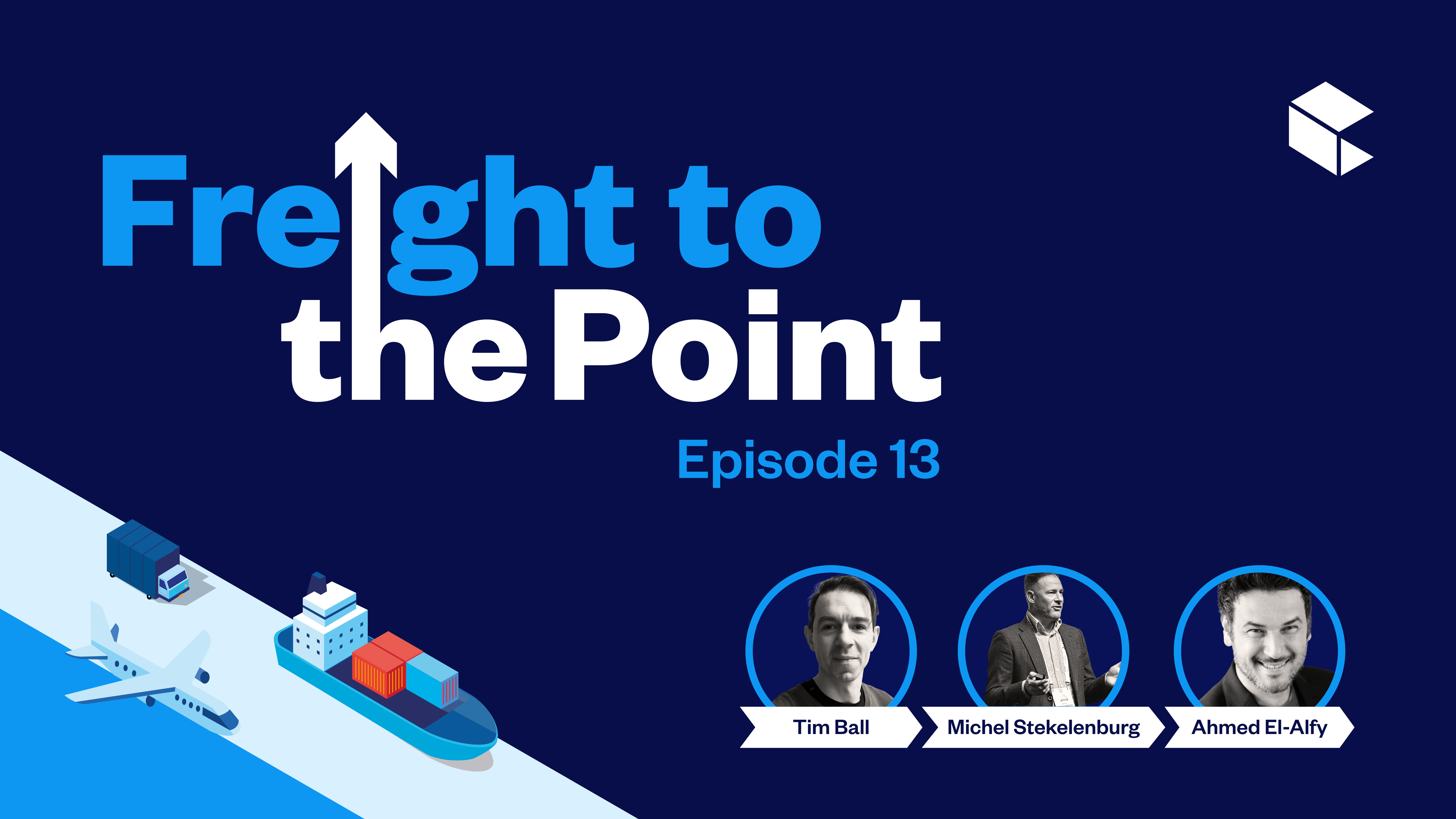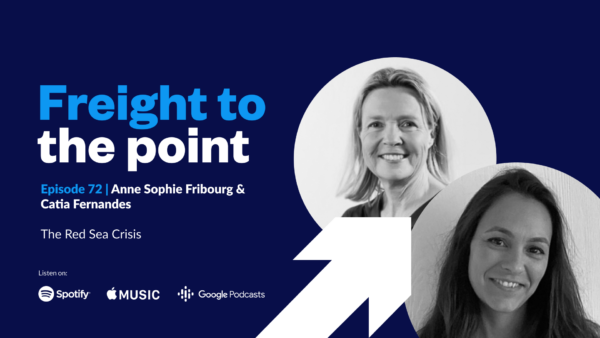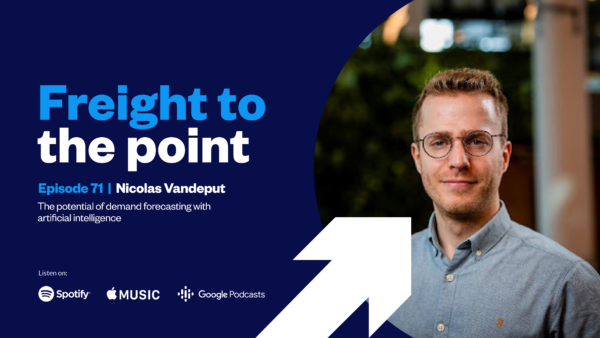Episode 13:
Using data to optimise performance with Michel Stekelenburg, Tim Ball and Ahmed El-Alfy
See all episodes

How much visibility do you have over your supply chain? Is it enough to make informed decisions?
Tim Ball, Director of Product Management is joined by Michel Stekelenburg, Director Strategic Accounts EMEA, project44 and Ahmed-El Alfy, Zencargo’s Strategic Account Manager to discuss how businesses can optimise performance in their supply chain through data.
They discuss:
- The benefits of granular visibility
- How businesses can ensure that their data is reliable
- How data can help with short and long-term strategies
Resources
- Data integrity: How does it strengthen your supply chain https://www.zencargo.com/resources/data-integrity-how-does-it-strengthen-your-supply-chain/
 Hello, and welcome to Episode 13 of Freight to the Point, a podcast from Zencargo. This week, we’re featuring one of our Navigate sessions, Best-in-class: Using Data to Optimise Performance. To give you a bit of background, our quarterly Navigate conferences invite leading supply chain experts to talk about what is happening in the industry and their predictions for the future. For this session, we invited Michel Stekelenburg, Director of Strategic Accounts for EMEA at project44, and Tim Ball, our own Director of Product Management, as well as Ahmed El-Alfy, or Alfy, our Strategic Account Manager from Zencargo. Tune into this episode as they explore how businesses should have visibility over their data to improve decision-making and optimise performance in their supply chain.
Hello, and welcome to Episode 13 of Freight to the Point, a podcast from Zencargo. This week, we’re featuring one of our Navigate sessions, Best-in-class: Using Data to Optimise Performance. To give you a bit of background, our quarterly Navigate conferences invite leading supply chain experts to talk about what is happening in the industry and their predictions for the future. For this session, we invited Michel Stekelenburg, Director of Strategic Accounts for EMEA at project44, and Tim Ball, our own Director of Product Management, as well as Ahmed El-Alfy, or Alfy, our Strategic Account Manager from Zencargo. Tune into this episode as they explore how businesses should have visibility over their data to improve decision-making and optimise performance in their supply chain.  Thank you, Helena. So, as Helena said, my background’s in technology product management, and so data is really, really core to the product management role in terms of understanding where the problems is, but also being able to show that any change you’ve made to a product has in fact improved it and that you can measure that change and measure that improvement to your business. So, which leads in nicely to this panel which is all about optimising your data. So, Michel, do you want to start with a quick intro and background and your take on the subject?
Thank you, Helena. So, as Helena said, my background’s in technology product management, and so data is really, really core to the product management role in terms of understanding where the problems is, but also being able to show that any change you’ve made to a product has in fact improved it and that you can measure that change and measure that improvement to your business. So, which leads in nicely to this panel which is all about optimising your data. So, Michel, do you want to start with a quick intro and background and your take on the subject?

 And Alfy, do you want to say a bit about what our customers are hearing on that?
And Alfy, do you want to say a bit about what our customers are hearing on that?

 What would say the benefit of more granular data is in terms of measuring performance? And Michel, if you want to start?
What would say the benefit of more granular data is in terms of measuring performance? And Michel, if you want to start?
So, I think first of all, data is key, right? We all know that we are in a data-driven economy, you could say. That’s also why we love partnering with companies like Zencargo to work as partners and to figure out what does the client need and how can we increase customer service levels. So, it all starts by having access to a mature life carrier integration network, because we need to have the data in place, but it also ties down to: What technologies are you using to validate the data? Are we getting reliable data? How do we do that? So, we as a company are a fully API-driven company. So we got certain processes in place to validate the information, but also to enrich the data, not just relying on the data which is coming from the carriers, but also using external sources, like weather forecast information, roadworks, roadblocks, historical data, and using machine learning and AI algorithms to make sure that you can predict the most accurate ETAs.

 And Alfy, what would you take on it be?
And Alfy, what would you take on it be?
Yeah. No, I agree with Michel a hundred percent. I mean, the data is quite an integral part. In my opinion, granular data is not just a benefit of gathering. It’s actually a necessity to have it. Without it, we are kind of blind, and I want to give this example around with this kind of miserable weather, but being on a flight, right? Imagine you want to board, waiting for the pilot to jump in. He joins in just straight from home. It’s like asking the cabin crew, “Where we going? Let’s go to Brazil. Fine, and close the door. How many passengers? 200, let’s shut the door, engine start, and let’s fly,” without doing anything else. I mean, do you want to be in that flight? I doubt because there are lots of other things that can happen wrong. Radio cannot work. Landing gears might not work. Weather conditions might not work. Other planes could be on the same latitude and we can crash into them. There lots of things that can go wrong. So, I really don’t want to be on that flight.
So, it’s the same thing. Every single pilot, they have to have data to give them proper insight from moving from point A to point B. They can’t just move. Irrespective of the size of the plane, be it a Cessna, a helicopter, a 777, it doesn’t matter. They still do it to take care of the passengers, the flight crew, and everyone else. Same thing for me as a supply chain professionals. Everyone is relying on us. As Michel rightly said, the customer expects the supply chain to be a hundred percent working properly, and our stakeholders, the merchandiser, the planning team, the freighters, everyone in the business is expecting it to work.

 Okay, yeah. So, both of you sort of mentioned, there’s often some challenges with getting this data. So, what do you think those kind of challenges are? How do you make sure you get data that’s good, reliable and comes in a kind of timely fashion, Michel?
Okay, yeah. So, both of you sort of mentioned, there’s often some challenges with getting this data. So, what do you think those kind of challenges are? How do you make sure you get data that’s good, reliable and comes in a kind of timely fashion, Michel?
Yeah. Well, I think that’s the biggest bottleneck we have in the industry, right? If you look at us being technology driven versus the carrier domain, maybe a bit less technology driven, that’s always a big challenge. It all ties down to what processes do you have in place and how can we support the industry, the carrier domain, for example, in becoming more technology driven. So, when I look at what we are doing here at Project44 is we are very close to the carrier market, right? I think we don’t see carriers just as being data providers. We see them as partners, meaning that we are always looking for ways. Of course, the end client is always looking, the shipper is always looking how can I exceed customer expectations, but if you reach out to a carrier, is it just a matter of asking them for data or can you support them also in boosting their business, right?
So, can you give something back to the industry? And that typically is a trigger for carriers. No matter if we’re talking about road carriers or ocean or air or rail or barge, to get excited about technology, you need to get them excited because it’s not their core business, and for example, what we are doing is things like we have something like Cooperative where every carrier connected to the platform can share capacity. So, for example, they are driving and dropping a shipment somewhere in Hamburg, and then they are driving back empty. But why is that, and how can you reduce empty miles, for example? So, what we’ve done is we said to these carriers, “Every carrier connected to the platform can decide to share that capacity among the shippers using our platform,” and then the shippers can book that capacity to prevent their driving back empty which is a benefit for the carrier, but also for the shipper, right, because then they can act faster.
So, how we look at that is it’s really working closely with the carriers, see them as partners, be able to add value, to give something back to these carriers so they see the advantages and they understand why it’s important to work with partners like P44, like Zencargo, to make sure that you have access to the right data, sit down with the carrier and figure out why is their data not always reliable and how can we improve that, right? It’s a partnership. It’s something we need to collaborate on, but it also ties down to providing the right tools to those carriers, making their lives easier, for example, on how to integrate with platforms like Zencargo, like P44. If you ask them to become part of a network and they need to start developing APIs themselves, for example, well, that could take some wealth, right? So, you need to make it as low profile, as easy as possible for them to connect and to be able to fuel platforms like Zencargo, like P44 with the right data.
So, try as an innovator to automate that process and to make it as easy as possible step by step to connect, for example, but it also ties down to technology which is available, right? So, if you look at road transport, we luckily have most of the trucks, in Europe at least, they are all equipped with telematics, right? So, they have their onboard computer with telematics. So, we automated the whole process of making the connection between the visibility platform where we basically collect all the data on behalf of our end clients and the connection directly into the board computer, into the telematics. So, basically there’s no interveniance between the carrier and the technology driver, P44 in this case. It is all managed directly by having this real-time connection. So, it all ties down, like technology needs to be in place, you need to motivate these carriers why it’s important and why it also adds value on their end, and then they are most willing to collaborate and figure out how can we improve data quality.

Michel, I mean, obviously automation and data is the harder as you said. I mean, the key things are from dealing with several customers that it comes to four things when it comes to challenges, and I’m sure when I mention them, you will probably think I am facing one, at least one of them or two. I’ll let me be optimistic. So, the first one is actually not knowing what data you need. That’s one of the biggest things that we might have. We’re not actually knowing what actually we’re trying to measure. The second thing is, okay, so I know what I want to measure, but I can’t find the data. It’s missing data. It’s just probably all over the place, multiple sources, as you say, spreadsheets across the business, different people managing those data sources, different, it’s just not in one place.

 So, I guess kind of for me taking example from another industry, so I used to work in online estate agencies. One of the things we were trying to do was sell about 20,000 each day worth of listings, and we used to have a data report middle of the week after on what we did the previous week because that was just how quickly we could get it. So, we then got to the point where we could report within a day, and halfway through a day, we could tell whether we were going to hit our number or not and take action to correct that. So, on top of good data, you need data that arrives when it’s useful to you. So, can you talk a little bit about the values within supply chain of getting data really, really quickly, about things that have gone wrong, or just things that are going well?
So, I guess kind of for me taking example from another industry, so I used to work in online estate agencies. One of the things we were trying to do was sell about 20,000 each day worth of listings, and we used to have a data report middle of the week after on what we did the previous week because that was just how quickly we could get it. So, we then got to the point where we could report within a day, and halfway through a day, we could tell whether we were going to hit our number or not and take action to correct that. So, on top of good data, you need data that arrives when it’s useful to you. So, can you talk a little bit about the values within supply chain of getting data really, really quickly, about things that have gone wrong, or just things that are going well?

Yeah. So, if you would ask me, you really got me excited? It’s more like where do I start. So, you just mentioned this example, Tim, one of the things is how can it help you boost profit, boost sales, right, and I always use the example of Amazon which actually is one of early adopters of visibility, you could say, at first for B2C and that became the standard which now is the standard, I would say too, in the B2B market. But Amazon, when they didn’t have visibility in place and products were out of stock and you were going to the Amazon website, it literally said out of stock because they couldn’t deliver.
Nowadays using visibility, and they actually work with P44, they use our reliable, accurate data to look into visibility at product level, to understand when can I expect new stock to arrive. So, if they know they need to deliver within three days, for example, and they see shipment is still in transit but it will be delivered in one and a half days, on the website, it already says it’s in stock and you can just order it and they can commit to delivering within three, two days, for example. So, from a sales perspective, it’s massive, it’s massive, but also from, from other angles, what about production, right? How many companies are still facing disruptions which are caused by major disruptions like COVID, like the Suez crisis, et cetera. If you know upfront and in an early phase there will be shipments impacted, you can start looking into things of rerouting, for example, right, or maybe sourcing raw materials from a different source.
So, also, how do I use real-time visibility to mitigate risk on any production levels, right? We talked about customer experience, how important isn’t it to better serve your clients, whereas the customer market is becoming more demanding day by day. They need to have real-time visibility. If you have your business running and you’re not able to provide real-time insights, you might lose business again. So, from a sales perspective, it is massive. It’s a huge advantage, a real benefit, but sometimes people also forget. If you look at your internal supply chain, many companies because they didn’t have real-time visibility, they were facing enormous costs for late delivery penalties, high cost for detention and demurrage, and typically we sit down with these clients and we ask them why is that, and the standard answer we are getting is we don’t have the data. We just don’t have the insights, right?
By having real-time visibility in place, you can understand why do I have these late deliveries, why is that container still standing in the dock, why hasn’t it been picked up yet, and you can start creating a more efficient and more sustainable supply chain. You can reduce cost for penalties, for detention and demurrage. Another angle is what we still see in the market is that there are so many inefficiencies. First of all, just the manual labour which is going into where is my truck. I need to call my forwarder to understand where my truck, where my container is. Well, if you automate that whole process, you can reduce with low calls where’s my order, right? You can reduce it significantly where customer service can start doing more strategic stuff, instead of just firefighting. Huge game-changer, I would say.
But also things like what we see still happening in warehouses is that the teams in the warehouse, they are waiting for a truck to unload, but the truck is one and a half hours late. They have not been informed. One and a half hours is lost or inefficiencies are there. So, when you know exactly when the truck will be arriving at the warehouse, you can start optimising your planning in these warehouses, another added value. If you know exactly where a stock is, then you can also take it to the next level and look into things like what are my safety stock levels, do I really need that, can I maybe reduce stock. And coming back to free time, detention and demurrage, for example, if you have real-time insights on dwell times, what is the average time it takes for a container to go through that port, then you can also start fine tuning your contracts and look into at port level, for example, how much free time do I actually need.

 Yeah. I think also like what touched on there in terms of customer service is something that’s big, I think where we use data a lot internally and say in cargo is around providing dashboards to all our teams so they can see what’s going on and so they can understand what’s going on in the rest of the business, and we can use that to make sure that they’re informed about how to provide great service to our customers. So, is there opportunities here that we can send to our customers or do we have fires where we need to move people from one role to another in order to help make sure that we are providing our great customer service? So, I think there’s a lot we can do with real-time data around that. Should we briefly jump into some questions from the audience? So, first one here we’ve got is how do you recommend using granular data to help with short and long-term strategies? Alfy, do you want to start?
Yeah. I think also like what touched on there in terms of customer service is something that’s big, I think where we use data a lot internally and say in cargo is around providing dashboards to all our teams so they can see what’s going on and so they can understand what’s going on in the rest of the business, and we can use that to make sure that they’re informed about how to provide great service to our customers. So, is there opportunities here that we can send to our customers or do we have fires where we need to move people from one role to another in order to help make sure that we are providing our great customer service? So, I think there’s a lot we can do with real-time data around that. Should we briefly jump into some questions from the audience? So, first one here we’ve got is how do you recommend using granular data to help with short and long-term strategies? Alfy, do you want to start?
So, I mean, I basically think that that question goes into how you basically get the data to align with the levels of expectations of the groundwork and then the strategic. I call it mainly best practices from companies that I’ve worked with that mainly it lies into tool processes, and I think one of them would be understanding what the company objectives and goals as a high level, and I call this process a bungee jumping approach, and I’ll come to that naming convention in a second. So, you go with their company objectives and understanding what your goals are. It goes down into the next level which is the supply chain strategic goals and what you’re trying to achieve to meet those company goals. Then you go into the tactics and understand what are the measures and metrics, all the health checks they’re going to need to review on a regular basis. Once you define those, you need to find out what data elements and what data sets are matching those goals.
So, now you’re still probably asking why it’s still called a bungee jumping approach. In normal circumstances, it’s called deep diving. So, we’re basically going at the top level at a company objective, and let’s deep dive. By the time the diver goes down all the way, it takes time. By the time the divers go the way up, it takes time. The reason why it’s called bungee jumping is because it’s so important to not be dwelling too much time trying to find things and figuring around what KPIs and metrics you’re trying to find. You need to stay up there. If you want to have data and metrics and measure, you just jump down, get the data, and up. Again, it needs to be very quick.
The second practical approach that I found customers and I find very helpful, and I’ve personally been engaged in several of them is mapping your supply chain. Map is so important. It’s like if I ask any of the audience again, but I ask you how long will it take you to give us a map of your entire supply chain, how long will it take you? If it takes more than five minutes, then it’s too long. So, how we do that is just simply just invest in time, sit down, find the gaps, map your supply chain, what the raw materials that you need, what suppliers, where are they based, what are my products, what are the packaging materials, what are the modes of transport that we’re using, what documents do we require. If we’re moving to Saudi Arabia, they need to have different requirements, and for Latin America, they have a different requirement.

 So, thank you very much for your insights there. I think, to me, one of the kind of the biggest takeaways is really around what can you do when you know that your cargo’s in transit and when you know and really trust the reliable data you have around that, what does that allow you to do, how does that allow you to optimise things so that it spends as little time as possible in your warehouse, and you can kind of reduce your margins, and take the opportunities there available to you. So, thank you very much for your time today, and over to Helena.
So, thank you very much for your insights there. I think, to me, one of the kind of the biggest takeaways is really around what can you do when you know that your cargo’s in transit and when you know and really trust the reliable data you have around that, what does that allow you to do, how does that allow you to optimise things so that it spends as little time as possible in your warehouse, and you can kind of reduce your margins, and take the opportunities there available to you. So, thank you very much for your time today, and over to Helena. Thank you for tuning into our episode this week. We really hope you enjoyed the insights from our Navigate Conference. If you have any feedback on this week’s episode, please do reach out to us on LinkedIn. We would love to hear from you, and don’t forget to like, subscribe, and share today’s episode with your network. If you’re interested in becoming a speaker on our next Navigate Conference later on in the year, please do get in touch, and we’d love to talk about this with you. But until next time, goodbye.
Thank you for tuning into our episode this week. We really hope you enjoyed the insights from our Navigate Conference. If you have any feedback on this week’s episode, please do reach out to us on LinkedIn. We would love to hear from you, and don’t forget to like, subscribe, and share today’s episode with your network. If you’re interested in becoming a speaker on our next Navigate Conference later on in the year, please do get in touch, and we’d love to talk about this with you. But until next time, goodbye.

Episode 72: The Red Sea Crisis
In the latest episode of Freight to the Point, we’ve featured our most rec...

Episode 71: The potential of demand forecasting with artificial intelligence
In the most recent instalment of Freight to the Point, Lucie Phillips, Zen...

Episode 70: Rates: What's next for 2024?
As we prepare for the year ahead, it's crucial to consider the three pillars...

